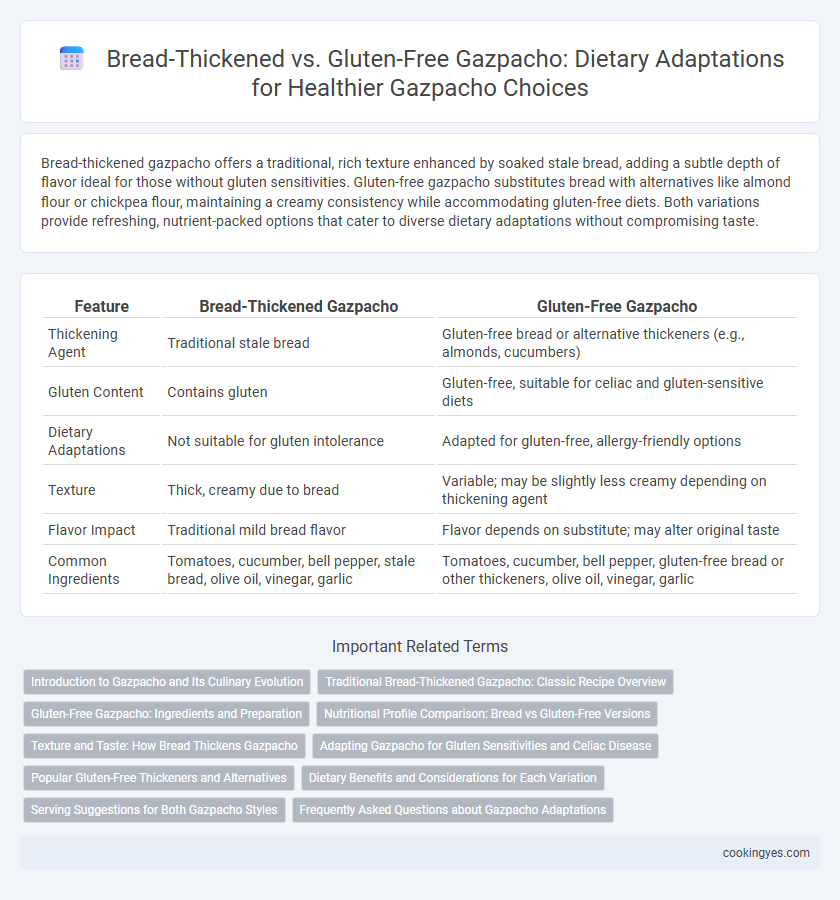Bread-thickened gazpacho offers a traditional, rich texture enhanced by soaked stale bread, adding a subtle depth of flavor ideal for those without gluten sensitivities. Gluten-free gazpacho substitutes bread with alternatives like almond flour or chickpea flour, maintaining a creamy consistency while accommodating gluten-free diets. Both variations provide refreshing, nutrient-packed options that cater to diverse dietary adaptations without compromising taste.
Table of Comparison
| Feature | Bread-Thickened Gazpacho | Gluten-Free Gazpacho |
|---|---|---|
| Thickening Agent | Traditional stale bread | Gluten-free bread or alternative thickeners (e.g., almonds, cucumbers) |
| Gluten Content | Contains gluten | Gluten-free, suitable for celiac and gluten-sensitive diets |
| Dietary Adaptations | Not suitable for gluten intolerance | Adapted for gluten-free, allergy-friendly options |
| Texture | Thick, creamy due to bread | Variable; may be slightly less creamy depending on thickening agent |
| Flavor Impact | Traditional mild bread flavor | Flavor depends on substitute; may alter original taste |
| Common Ingredients | Tomatoes, cucumber, bell pepper, stale bread, olive oil, vinegar, garlic | Tomatoes, cucumber, bell pepper, gluten-free bread or other thickeners, olive oil, vinegar, garlic |
Introduction to Gazpacho and Its Culinary Evolution
Gazpacho, a traditional Spanish cold soup, originally relied on stale bread to achieve its signature thick texture, enhancing both flavor and mouthfeel. Modern dietary adaptations include gluten-free versions that substitute bread with ingredients like cucumber or avocado, catering to gluten intolerance while preserving the soup's refreshing qualities. This culinary evolution reflects a balance between maintaining authentic taste and accommodating diverse dietary needs.
Traditional Bread-Thickened Gazpacho: Classic Recipe Overview
Traditional bread-thickened gazpacho relies on stale bread to create its characteristic creamy texture while intensifying the soup's rich, fresh vegetable flavors. This classic Spanish recipe uses simple ingredients like ripe tomatoes, cucumbers, bell peppers, garlic, olive oil, and sherry vinegar, where the bread acts as a natural thickener without overpowering the balance of acidity and freshness. For those seeking authentic taste and texture, maintaining the bread component is essential, though gluten-free alternatives adapt the soup for dietary restrictions without replicating the exact creaminess.
Gluten-Free Gazpacho: Ingredients and Preparation
Gluten-free gazpacho replaces traditional bread with alternatives like rice bread or almond flour to maintain a smooth, thick texture without gluten. Key ingredients include fresh tomatoes, cucumbers, bell peppers, garlic, extra virgin olive oil, sherry vinegar, and a pinch of sea salt, all blended until creamy. Chilling the soup for several hours enhances flavors and ensures a refreshing, allergen-friendly dish suitable for gluten-sensitive individuals.
Nutritional Profile Comparison: Bread vs Gluten-Free Versions
Bread-thickened gazpacho contains soluble fiber and carbohydrates from the bread, contributing to higher energy content and moderate protein levels. Gluten-free gazpacho versions often use alternative thickeners like rice or almond flour, resulting in lower carbohydrate density and fewer calories, ideal for gluten-sensitive or low-carb diets. Both variants provide essential vitamins and antioxidants from fresh vegetables, but the choice impacts overall macro-nutrient balance and dietary tolerance.
Texture and Taste: How Bread Thickens Gazpacho
Bread-thickened gazpacho uses soaked stale bread, which adds a creamy, velvety texture and a subtle yeasty flavor that enhances the soup's depth. Gluten-free gazpacho substitutes bread with alternatives like ground almonds or rice, resulting in a lighter texture and a more pronounced fresh vegetable taste. The bread's gluten structure helps emulsify ingredients, creating a thicker consistency that gluten-free options often achieve through blending techniques or added thickeners.
Adapting Gazpacho for Gluten Sensitivities and Celiac Disease
Bread-thickened gazpacho traditionally incorporates stale bread to create a rich, creamy texture, but this poses challenges for individuals with gluten sensitivities or celiac disease. Gluten-free gazpacho substitutes ingredients like almond bread, rice crackers, or simply omits bread, ensuring a safe and delicious option without compromising the fresh vegetable flavors. Carefully selecting gluten-free thickeners maintains the authentic taste and nutritional benefits of traditional gazpacho while accommodating dietary restrictions.
Popular Gluten-Free Thickeners and Alternatives
Bread-thickened gazpacho traditionally uses stale bread to create a smooth, creamy texture, but gluten-free adaptations often replace bread with popular thickeners like ground almonds, chickpea flour, or cooked rice to maintain consistency. These alternatives provide similar body and mouthfeel while accommodating gluten intolerance and celiac disease dietary requirements. Using vegetables such as avocado or adding seeds like chia can also enhance thickness naturally without gluten.
Dietary Benefits and Considerations for Each Variation
Bread-thickened gazpacho provides essential carbohydrates and a rich texture but may not suit those with gluten intolerance or celiac disease due to its wheat content. Gluten-free gazpacho offers a lighter, allergy-friendly option using alternative thickeners like cucumber or almonds, supporting a broader range of dietary needs. Each variation balances nutritional benefits with dietary restrictions, making them adaptable for heart-healthy and gluten-sensitive individuals.
Serving Suggestions for Both Gazpacho Styles
Bread-thickened gazpacho offers a hearty texture ideal for pairing with crusty bread or savory tapas, enhancing the traditional Andalusian flavor profile. Gluten-free gazpacho, often thickened with vegetable purees or nuts, pairs well with fresh vegetable sticks, avocado slices, or gluten-free crackers to maintain its light, refreshing qualities. Both versions benefit from toppings like diced cucumber, bell peppers, and a drizzle of extra virgin olive oil to elevate the taste and texture.
Frequently Asked Questions about Gazpacho Adaptations
Bread-thickened gazpacho traditionally uses stale bread to create a creamy texture, but individuals with gluten intolerance or celiac disease should opt for gluten-free gazpacho versions made without bread or with gluten-free bread substitutes. Common questions include how to maintain the authentic flavor and consistency when omitting bread and which vegetables best enhance the natural freshness without adding gluten. Nutritional adaptations often focus on balancing texture and taste while ensuring the dish remains safe for those with gluten sensitivities.
Bread-thickened Gazpacho vs Gluten-Free Gazpacho for dietary adaptations Infographic

 cookingyes.com
cookingyes.com